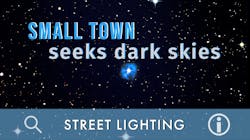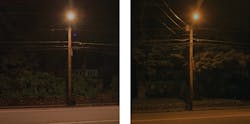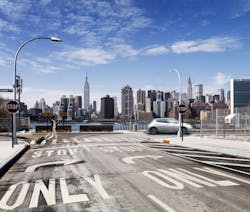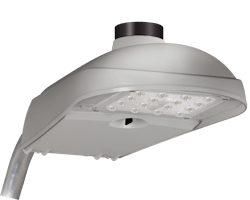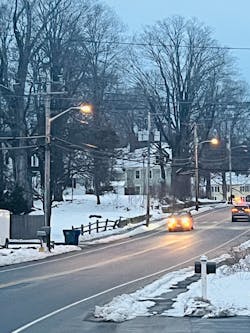PROJECTS | Dark-sky town opts for 2200K streetlights
When LEDs started to gain popularity in the 2010s, some cities jumped in right away, putting the energy-efficient technology to work on lighting streets. By 2013, for example, Los Angeles had converted 140,000 streetlights to LEDs, transforming the iconic orange glow of the city to a place crisp and color-saturated under its bright white lights.
Others moved more slowly. Over the last decade, Boston has been replacing old streetlights with LEDs as part of its carbon emissions–cutting strategy. Still, in 2019, Public Works Streetlights made up more than 9% of municipal emissions, which is why the city is planning to convert its tens of thousands of conventional streetlamps — and even a few thousand historic gas streetlamps — to LEDs.
Now, regulators across the U.S. are cracking down on energy use and environmental hazards. But while LEDs seem to have a bright future, communities and experts alike are worried about dark skies.
A recent study in Science found that the average night sky became 9.6% brighter between 2011 and 2022. This is a higher rate than many experts anticipated, partly because current tools used for measuring light pollution — such as weather satellites — are essentially blind to the blue light emitted by LEDs. This is a problem because the impacts of light pollution range from disrupted circadian rhythm in humans to altered animal migration patterns and to trees misinterpreting the light for a long summer. Any of these can lead to a cascade of ecological impacts. To help reduce light pollution, some cities are perhaps surprisingly turning back to the source — LEDs — but with a new understanding.
A little town with big ideas
An hour’s drive northwest from the glow of Boston, the self-declared dark-sky friendly town of Pepperell, Mass., is doing its part to reduce energy usage and light pollution. In late 2021, the town finished replacing its streetlights with 413 advanced LED fixtures. But its journey was not straightforward.
In 2009, when resident Tim Brothers started working at MIT’s Wallace Astrophysical Observatory, where he is now the observatory manager, he could easily spot the Milky Way in the inky black sky. But light pollution from surrounding areas had been steadily encroaching on the rural community, increasing skyglow by 6.8% per year, according to observations from 2012 to 2020.
Pepperell is one of the few communities left in the state that can see the stars clearly, noted Brothers, an active member and former vice president of the Massachusetts chapter of the International Dark-Sky Association (IDA). “We have watched our sky brightness increase year after year to the point where the Milky Way is completely washed out when it used to be visible in the summer months,” he said. In fact, his activism began in summer 2017, when he planned to show students the Milky Way at the observatory, but then discovered they could not see it. After returning home to Pepperell, he marveled how the galaxy loomed large above and knew he needed to preserve that view.
Coincidentally, Brothers was already serving on the town's Light, Air, and Noise Bylaw committee. In winter 2019, when Pepperell was in the early days of considering a streetlight retrofit to save energy and money, the town administrator, Andrew MacLean, reached out to Brothers for input. After Brothers spoke about the negative effects of light pollution, the project became a broader effort to ensure the new streetlamps would improve visibility while limiting contribution to light pollution. “I’m a lifelong stargazer and educator in astronomy,” Brothers said. “I always cared, but I would say my motivation increased as more scientific evidence was published demonstrating how dangerous light pollution is for human and animal health.”
Helping the town understand the potential cost savings was also an important part of early discussions. “When converting from HPS [high-pressure sodium] to LED lighting, you are almost guaranteed to save energy and, therefore, save funds,” Brothers said. “Once we walked through the additional savings potential of smart controllers, it was an easier sell to set lighting levels to only what is needed.”
From ideation to completion, the process to convert the town’s HPS streetlights to LED fixtures took just over two years. This was longer than anticipated largely due to the COVID-19 pandemic and supply chain holdups. Town authorities also had to purchase the streetlights from the local utility — for $1 each. “It’s a little bit of a challenge,” said MacLean. “[The utility did not] want to sell [ownership of the lights to us], because they’re getting that facility fee.”
Once their legal teams were in talks, the city's project contractor, RealTerm Energy, conducted a survey to confirm the inventory of streetlights, which found the city had been charged for a few streetlights that did not exist. “They don’t actually have a meter on every bulb,” MacLean said, noting that the utility previously charged a flat rate for each streetlight based on the type of lamp and hours on.
One drawback to the city owning the streetlights is that maintenance would fall under its purview; previously, the utility company would oversee maintenance as part of the facility fee. Now, the city works with a contractor to maintain their streetlights under an annual budget of approximately $10,000. However, the break/fix contract they have in place means there’s no upfront cost for maintenance. “If we don’t call them, we don’t pay them,” MacLean said.
A key project milestone was giving community residents a chance to see the streetlight candidates in action — Brothers' idea. For two weeks in April 2021, 12 luminaires demonstrating six different types of streetlights in a range of sizes and correlated color temperatures (CCTs) were placed on Pepperell’s Main Street. These included five different models of LED streetlights, all with CCTs under 2700K from various manufacturers, and one HPS streetlight. For the first week, the prospective luminaires were set to 100% brightness, followed by 50% brightness for the second week. During this time, a public survey was distributed to gauge resident preference; about 125 people responded. “[The votes were] pretty much equal between the HPS and the 2200K [LEDs],” MacLean said. No one seemed to notice the brightness had been lowered, and some respondents even complained that the streetlights were too bright, Brothers said.
With energy efficiency a town priority, the 2200K LED was the clear winner. “It’s closer to what we were replacing, which is the traditional HPS lights that have that warmer yellow look to them instead of that stark, bright white that you see in some LEDs,” MacLean said.
The “early and often” public consultation was likely a major factor in the project’s success, said John Barentine, an astronomer and principal consultant at Dark Sky Consulting, in Tuscon, Ariz. Though Barentine was not directly involved in the Pepperell project, he had worked as the director of public policy for the IDA at the time and knew of Brothers’ efforts. “Where this seems to go wrong is when cities make decisions without consulting their residents,” he added, “and we’ve seen this play out over and over again in different places in America.”
A new low for bright lights
The 2200K luminaire the town chose is Cooper Lighting Solutions’ Archeon Nano, which represents some of the latest LED technology to hit the streetlighting market. The smallest and most cost friendly of the Archeon series boasts an efficacy of 164 lm/W, output packages ranging from 2,000 to 7,800 lumens, and a cobra head style.
Ultimately, Pepperell town management set the fixtures to run at 50% capacity during evening hours and at 30% capacity between midnight and dawn. The lower light level saves more energy and money, reduces light emissions, and also gives the luminaires room to grow. All types of lighting decrease in output over time, Barentine said. Operating the luminaires at lower capacity will allow the town to increase brightness to make up for aging lights later on.
MacLean said the town considered starting with higher brightness levels, but Brothers encouraged them to go lower — after all, the town could always raise the brightness if residents complained about visibility. To date, MacLean said, “We’ve received zero complaints that the lights aren’t bright enough.”
The town’s shortlist of streetlight manufacturers was no accident. Pepperell’s contractor on the project had approached Cooper Lighting about the retrofit in late 2020. Intrigued by the town’s interest in utilizing LEDs under 2700K, Cooper Lighting took on the project after that initial contact, said Spencer Pidgeon, the company’s northeast regional sales manager for infrastructure. “We’re definitely seeing a trend towards warmer … color temperatures for roadway lighting,” he said, noting Cooper Lighting had just released its 2200K product line, believing it would be ideal for any aspiring IDA Dark Sky Community. “When I first started … everybody was really going after 4000K.”
The Archeon Series features a “discrete LED platform,” Pidgeon said; not only can each individual luminaire be controlled, but also each diode as well, with smart controls from Ubicquia (though any controls solution using the NEMA seven-pin receptacle on the luminaire should work, Pidgeon added). The series currently has five different form factors; Pepperell selected a mix of the smallest and mid-sized streetlights, which all work on the same smart network. The town receives daily notifications from the network about any power failures, fixtures inadvertently tilted due to, say, getting hit by a car, or operating malfunctions, MacLean said.
Pidgeon said dark-sky friendly lighting relies upon optics and optical control to allow users to put the right amount of light where it is needed. “We’re not in the business of overlighting spaces,” he said. Most of Cooper’s roadway products have an uplight rating of U0, meaning they’re designed to emit zero light into the sky, he added. “It’s what the industry and what our customers are asking for, and we’re trying to be good stewards of the night sky.”
Tips for aspiring dark-sky communities
The town of Pepperell did streetlighting well by considering factors outside of CCT, Barentine said. The emerging consensus among researchers, he continued, is to avoid focusing on one element of lighting design, which is also reflected in the IDA’s Five Principles for Responsible Outdoor Lighting. For example, a CCT under 3000K isn’t enough to make things dark-sky friendly if the light output is excessive, or if the sources are directed away from where light is needed.
Brothers offered the following checklist for prospective streetlight retrofits:
- A U0 rating, or little to no uplight emission.
- A CCT of 2200K to 2700K to reduce harmful blue light and limit scattering in the atmosphere.
- Set the luminaire to emit only the amount of lumens needed for a specific task.
- Consider overall streetlight inventory and whether some fixtures are superfluous.
He said some Pepperell stakeholders were skeptical that the dark-sky advocates’ wish list for the new streetlights — full shielding, U0, 2700K maximum CCT, a public demonstration, smart controllers, among other requests — was achievable. “One common misconception is that doing the right thing costs more, or that it is too hard,” Brothers said. “If you look at the results, I think we proved both of those wrong.”
MacLean said financing for the project essentially resulted in no extra cost, thanks to the $35,000 annual savings in electricity bills. The town’s payments for the project are spread over seven years, one year longer than the expected return on investment. MacLean did note that some of the luminaires failed in the first few months, though at least one of the failures was due to an automobile accident. “Once you get through the quality-control stuff, the [LED lamps] are going to be good for 15 to 20 years,” he said. And the town still has not had to raise the streetlight budget. “We’re ahead already, because we probably would have increased the budget just for utility rate increases.”
Beyond the financials and reduced electricity consumption, the streetlights’ advanced controls offer benefits in public safety. “The smart controllers allow us to turn individual lights on and off,” MacLean said. “Let’s say there’s a lost child. We could turn the lights on [to higher levels] in the neighborhood so people could look after dark.”
Brothers’ final word of advice for avoiding the glare, citizen complaints, and fading purplish lamps that many early LED adopters have unfortunately experienced is simple: “Take your time.”
Project credits
- Streetlight project management firm: RealTerm Energy
- Lighting manufacturer: Cooper Lighting Solutions
- Controls manufacturer: Ubicquia
SHEL EVERGREEN (shelevergreen.com) is a science journalist and multimedia professional based in Colorado. She’s produced work for MIT Technology Review, Ars Technica, Canary Media, and more. In her spare time, she volunteers as a mentor to young writers and hangs out in the mountains with her partner and pets.
For up-to-the-minute LED and SSL updates, follow us on Twitter. You’ll find curated content and commentary, as well as information on industry events, webcasts, and surveys on our LinkedIn page and our Facebook page.

Shel Evergreen
SHEL EVERGREEN (shelevergreen.com) is a science journalist and multimedia professional based in Colorado. She’s produced work for MIT Technology Review, Ars Technica, Canary Media, and more. In her spare time, she volunteers as a mentor to young writers and hangs out in the mountains with her partner and pets.
